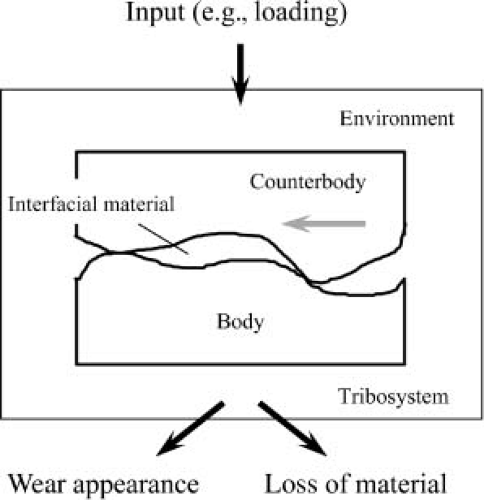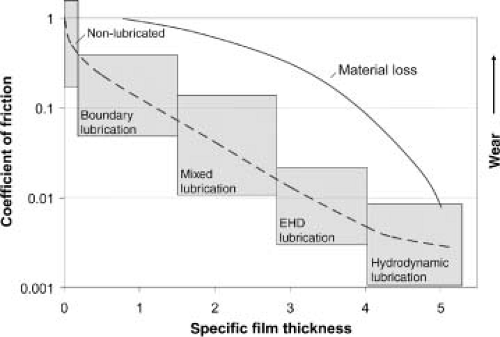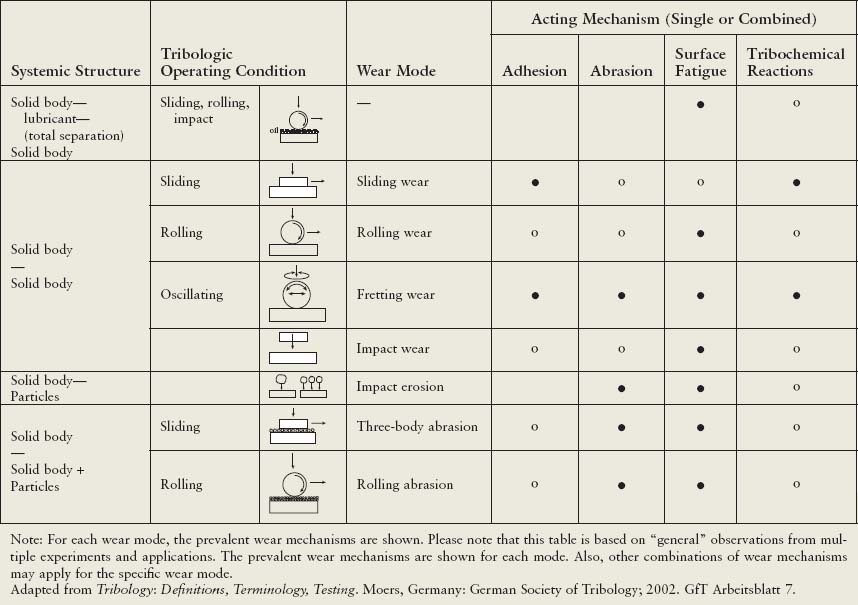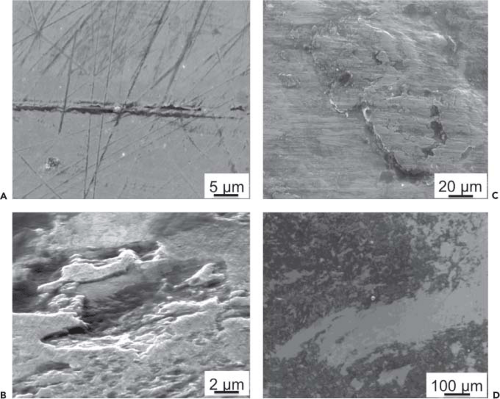Tribology
Markus A. Wimmer
Alfons Fischer
Robin Pourzal
History of Tribology
Tribology, derived from the Greek terms for rubbing (τριβειν) and science (λογοσ), has been defined as “the science and technology of interacting surfaces in relative motion.” Tribology comprises scientific and technical aspects of friction, wear, and lubrication and has made its appearance in many scientific branches, including orthopedics.
For several millennia, humankind has been aware of friction and wear. Cavemen used friction to light a fire by rubbing sticks on a piece of wood. The Egyptians and Sumerians (3500–35 BC) used leather belts to reduce friction between the axle and wheel of their carriages (1). Water, oil, fat, or bitumen served as early lubricants, the use of which permitted the transport of the stone blocks needed to build the pyramids. The first scientific approaches to analyze friction and wear were made by Italian Leonardo da Vinci (1452–1519). Da Vinci measured the frictional forces of bodies sliding on horizontal and inclined planes. He found that the frictional force depended on the normal load but was independent of the apparent contact area. He also studied the wear on technical bearings and recommended an alloy of three parts of copper and seven parts of tin as the material of choice.
Two centuries later, in France, Guillaume Amontons (1663–1705) confirmed independently the work of Leonardo da Vinci that the frictional force depends on the normal load but not on the apparent area of contact. His observations on dry friction of solid bodies, in addition to those of his French compatriot Charles Augustin Coulomb (1736–1806), are commonly referred to as Coulomb’s laws. In addition, the Englishman Sir Isaac Newton (1646–1727) was active in this scientific branch. He became aware of the favorable influence of lubricants in reducing friction and wear and described their viscosity by means of fluid mechanics.
Two centuries later, the German Richard Stribeck (1861–1950) determined adhesion, deformation, and lubrication as the principal portions of friction. With these newly developed laws it became possible to describe the sliding frictional behavior of both lubricated and nonlubricated metal-on-metal (MoM) joints. Because of the complex nature of friction and wear and the required interdisciplinary approach, a commission was founded by the British Department of Education and Science, in 1966, with the task of defining the scientific evaluation of friction, wear, and lubrication and of introducing the necessary interdisciplinary tools needed to solve the related problems (2). This commission defined the term “tribology” in 1966.
In contrast with natural synovial joints, which have excellent characteristics of low friction, high load-carrying capacity, shock absorption, and long endurance, many total joint prostheses have shown serious problems such as component failure and joint loosening due to wear. It was Sir John Charnley who introduced tribologic thinking to the medical community as a result of his early, clinically unsuccessful experience with Teflon (3). This well-known low-friction material had extremely poor wear characteristics when articulating against metallic surfaces in vivo. Large amounts of generated debris caused severe inflammatory reactions, which rapidly led to loosening of the artificial devices. This emphasized the need to consider all the characteristics of a material under tribologic stresses carefully prior to implantation in humans.
Systemic Aspects of Tribology
Definitions, Terms, and Structure of a Tribologic System
Friction arises from the interaction between moving solids in contact and hinders (sliding friction) or prevents (static friction) motion. Friction is the introduction, transformation, and dissipation of energy and may lead to loss of material. This (progressive) loss of particulate debris from the surface of a solid body due to mechanical action has been defined as wear. Although mechanical fracture of the component may also occur in extreme contact cases, wear typically results in dimensional and topographical changes as well as surface damage. This can cause secondary problems such as misalignment or—in extreme cases—seizure of the joint. The generation of wear debris, however, is in many cases even more detrimental than the actual dimensional change of components. Entrapped particles act as the interfacial medium and may change the acting wear mechanism. The effect of entrapped particles is, therefore, as important as their generation.
Although the mechanical properties of engineering materials can be described in terms of strength and toughness, friction and wear are not intrinsic material properties. Wear
and friction are characteristic to a specific tribosystem and incorporate the physical (e.g., Young modulus or thermal conduction) as well as the chemical properties (e.g., reactivity) of surfaces (4). A tribosystem consists of four principal elements: body, counterbody, interfacial medium, and environment (4,5). The operating variables load, relative speed, ambient temperature, and loading time bring about motion and work as an input to the system, resulting in motion and work as output. The loss of the system can be defined in terms of energy (heat or sound) and material (wear debris). Figure 17.1 shows a schematic of a tribosystem.
and friction are characteristic to a specific tribosystem and incorporate the physical (e.g., Young modulus or thermal conduction) as well as the chemical properties (e.g., reactivity) of surfaces (4). A tribosystem consists of four principal elements: body, counterbody, interfacial medium, and environment (4,5). The operating variables load, relative speed, ambient temperature, and loading time bring about motion and work as an input to the system, resulting in motion and work as output. The loss of the system can be defined in terms of energy (heat or sound) and material (wear debris). Figure 17.1 shows a schematic of a tribosystem.
As wear and friction arise from conditions at the interface, the properties of the surfaces in contact need to be looked at. Technical surfaces are far from being smooth, and exhibit varying degrees of roughness, ranging from the nanometer to millimeter scale. Figure 17.2 highlights the differences between apparent and real contact area on the micrometer scale. The irregularities of the surface usually consist of broad-based hills with angles of inclinations of less than 15 degrees from the base (6). The ratio of real to apparent area of contact changes constantly during motion and can range from <10−4 to 1. This is dependent on the statistical distribution of topographical irregularities, the acting shear and normal contact forces, as well as the mechanical, physical, and chemical properties of the materials in contact, which might be distinctly different from the bulk properties.
Because of the complex nature of friction and wear, the problems of tribology are difficult to assess by any simple model. The system approach as depicted in Figure 17.1 is an easy-to-use approach, which can be applied for any tribologic problem from an engineering point of view. To define the limits of this approach as well as its possibilities, it is mandatory to analyze worn surfaces under real operating conditions, for example, hip joints from patients with complete medical history and clinical follow-up. Of course, this is a time-consuming and expensive process. A suitable wear-testing apparatus should then reflect the structure of the tribosystem and the type of dynamic interaction between its elements. It should be considered that the proper modeling of the input parameters, for example, loading and motion of the joint, will determine the acting wear mechanisms, while in turn a suitable wear-resistant material must be chosen with respect to them (7). In other words, the key to any solution of a tribologic problem is inextricably linked to the knowledge of the wear mechanisms as well as the sequence and interdependence of their acting. The authors stress the importance of knowledge of the acting wear mechanisms, since it is known that even for the same wear mode different design or material modifications are appropriate. For example, the parameters of the wear mode “three-body abrasion” of a MoM bearing with incorporated mineral particles can change in such a way that the mechanism “adhesion” (cold welding of surface spots by plastic deformation of surface asperities), abrasion (grooving of surfaces by plastic flow), or “surface fatigue” (predominantly cyclic elastic deformation) applies. Thus, a successful plan to improve the characteristics of the materials in contact demands an exact understanding of the structure of the tribosystem and the interaction of its elements. At first, information on prosthesis design, joint kinematics, and kinetics in the physiologic situation is requested. In the following subsections, we will introduce the relevant terminology regarding friction and wear on the basis of the historical development of today’s available systematic, empirical approaches. In doing this, the knowledge of the acting wear mechanism is essential to identify precise and purposeful measures for wear reduction and, thus, to overcome simple trial-and-error methods. Theoretical models based on mechanical finite-element or chemical molecular dynamics computer simulations will not be regarded here, because, up to date, they only investigate a very small volume of interest and do not incorporate the entire tribosystem. Nevertheless, these models are very helpful in guiding the way from the systematic engineering approaches to the atomistic, theoretical level and facilitate a better understanding of specific single effects on friction and wear (8,9).
Friction
Friction is generally understood as the introduction, transformation, and dissipation of energy. The introduction of friction is accomplished by cyclic elastic or plastic deformation of contact spots of the real contact area. Then it is transformed into elastic or plastic deformation energy within interlocking surface asperities (10,11) and/or leads to crack initiation and propagation (12,13). This describes the deformation term of friction, which might also be responsible for the generation of particles. Another contribution comes from the adhesion of the surface atoms and molecules of body and counterbody.
The probability of adhesion depends on mechanical properties (14) and the tendency of atoms and molecules to react chemically (15,16). Both the deformation and adhesion contribution to friction can be distinctly lowered by means of surface modifications or coatings as well as by lubrication. At least 90% of the introduced energy is dissipated by transformation into heat (17,18,19,20,21), leading to an increase of the temperature within the contact zone. Depending on local normal forces and the relative velocity, the average as well as the so-called flash temperatures may rise. Although the average temperature is primarily governed by the normal force, the flash temperature depends mostly on the relative velocity and lasts for only a few milliseconds. The remaining 10% is dissipated by storing mechanical energy within lattice defects generated by cyclic elastic and plastic deformation (22), phase transformation (23), or chemical reaction of body, counterbody, interfacial medium, and environment (24).
The probability of adhesion depends on mechanical properties (14) and the tendency of atoms and molecules to react chemically (15,16). Both the deformation and adhesion contribution to friction can be distinctly lowered by means of surface modifications or coatings as well as by lubrication. At least 90% of the introduced energy is dissipated by transformation into heat (17,18,19,20,21), leading to an increase of the temperature within the contact zone. Depending on local normal forces and the relative velocity, the average as well as the so-called flash temperatures may rise. Although the average temperature is primarily governed by the normal force, the flash temperature depends mostly on the relative velocity and lasts for only a few milliseconds. The remaining 10% is dissipated by storing mechanical energy within lattice defects generated by cyclic elastic and plastic deformation (22), phase transformation (23), or chemical reaction of body, counterbody, interfacial medium, and environment (24).
Lubrication
Wear can be reduced by lubrication. The principal idea behind lubrication is to interpose a material between two contacting solids to minimize interaction between them. For example, wetting of the surfaces reduces adhesion. The extent of fluid film formation plays an important role in the wear process of artificial joints in vivo. It has been pointed out that, under wet conditions, the wear rate of ultra-high molecular-weight polyethylene (UHMWPE) decreases steadily with decreasing counterface roughness, whereas under nonlubricated (dry) conditions an optimum roughness exists (due to the competing mechanisms adhesion and abrasion) (25). Therefore, an adequate surface finish of the prosthetic head (at least Ra <0.05 μm) without imperfections is recommended when paired with UHMWPE (26).
The effectiveness of a lubricant film is defined by the specific film thickness λ which depends on the viscosity of the lubricant, the relative velocity between body and counterbody, the pressure across the interface, and, last but not least, on the roughness of the mating surfaces. Thus, λ can be used to estimate the occurrence of different lubrication regimes, as shown in Figure 17.3. In the case of boundary lubrication, the lubricant adheres chemically to one of the surfaces, and there is full contact between the solids, in contrast to hydrodynamic lubrication where a total separation of the two bodies takes place. Elastohydrodynamic (EHD) lubrication occurs when the pressure in the fluid film is sufficiently high to deform the asperities of the solid surfaces. Thus, even if the thickness of the fluid film is smaller than the heights of the asperities of body and counterbody, a total separation may be still achieved. Under realistic loads and in the presence of synovial fluid, metal/plastic hip joints articulate in the mixed film (27) or boundary (28) lubrication regime. Hard/hard bearings primarily work in the EHD and mixed film lubrication regime (29); however, with increasing femoral head size (>28 mm) a shift toward full fluid film (hydrodynamic) lubrication can be observed as well (30).
Wear
Wear has been defined as removal of material from the body in contact as a consequence of mechanical action; thus, creep or plastic deformation are not forms of wear per se because they do not produce wear debris but dimensional changes of the contacting surfaces. Furthermore, corrosion is not directly related to wear because it can take place without mechanical activation at all. To be able to describe wear phenomena unequivocally, it is strongly suggested to distinguish between wear modes, wear appearances, and wear mechanisms (6).
Wear Mode
The wear mode defines the general mechanical conditions under which the bearing is functioning when wear occurs. Wear modes are defined by two sets of criteria: first by the macroscopic structure of the tribosystem and the kinematic interaction of its elements and second by the combination of acting wear mechanisms. Table 17.1 displays a selection of relevant wear modes that have been put together following a suggestion of the German Society of Tribology (31).
It should be noted that the wear mode is not a steady-state condition and can transform from one to another. For example, particulate debris generated by two-body abrasion may function as interfacial medium and turn the problem into a particle (=three-body)–related phenomenon. Depending on the circumstances, this may reduce or increase the wear rate.
Wear Mechanisms
The wear mechanisms describe the mechanical, physical, and chemical interaction of the elements of a tribosystem. Today, four major wear mechanisms are distinguished: abrasion, surface fatigue, adhesion, and tribochemical reactions. Whereas abrasion and surface fatigue are purely mechanically dominated, adhesion and tribochemical reactions are the effect of combined mechanical and chemical action.
Nearly all implants that have been removed from patients exhibit grooves and/or scratches; thus, abrasion is one of the most obvious wear mechanisms. Abrasion may be induced by foreign particles (contaminants from outside the wear system, e.g., bone cement) or by system-inherent particles
(e.g., fractured carbides, wear debris). Depending on the local contact situation (e.g., attacking angle, sharpness) and the properties of the bodies in contact (e.g., hardness, fracture toughness, strength, ductility), abrasion may reveal four different submechanisms like micro-plouging, -cutting, -cracking, and -fatigue reflecting the cyclic elastic and/or plastic nature of the contact (6). Although the main wear loss is attributed to abrasion in many references, it is often questionable whether this wear mechanism initiated the failure sequence.
(e.g., fractured carbides, wear debris). Depending on the local contact situation (e.g., attacking angle, sharpness) and the properties of the bodies in contact (e.g., hardness, fracture toughness, strength, ductility), abrasion may reveal four different submechanisms like micro-plouging, -cutting, -cracking, and -fatigue reflecting the cyclic elastic and/or plastic nature of the contact (6). Although the main wear loss is attributed to abrasion in many references, it is often questionable whether this wear mechanism initiated the failure sequence.
Table 17.1 A Synopsis of Wear Modes | |
|---|---|
|
Surface fatigue acts during repeated sliding or rolling over the same wear track. The repeated loading and unloading can induce the initiation and propagation of microcracks parallel and orthogonal to the surfaces for mechanical (32) or material-related (33,34) reasons. As a result, shallow pits and filaments (delaminations) are generated.
During adhesion, material from both surfaces adheres to each other within the contact spots. This process is similar to friction welding. During mechanical action, these microjunctions are torn off and fragments may become particles or are being transferred from body to counterbody and vice versa, bringing about surface damage in the form of flakes and pitting. If the generated flakes and particles are bigger than the clearance of the bearing, they may act as abrasive particles or even block the joint. In particular, metals with high ductility in a self-mating contact situation experience adhesion (35,36).
Tribochemical reactions occur when surfaces in mechanical contact react with the interfacial medium and the environment, resulting in the alternating formation and removal of chemical reaction products at the surfaces. Mechanical and thermal activation of the surfaces due to friction leads to contact spots with an increased chemical reactivity (37); such that, for example, oxidized islands are generated (38). These oxide layers spall off the surfaces after reaching a critical thickness. It is also possible that the interfacial medium (e.g., synovial fluid) is directly involved in the generation of tribochemical reaction layers with sustained effects to friction and wear of the bearing (39). This process is similar to the action of the so-called extreme-pressure (EP) additives within high-performance lubricants for motors of passenger cars or trucks.
Wear Appearance
The wear appearance describes the visible changes of a surface texture, composition, or shape as a consequence of wear. “Wear features”, “wear patterns,” or “wear damage” have been used synonymously in the literature. The wear appearance is a characteristic sign of the underlying wear
mechanism (Fig. 17.4). A detailed study of the various features left behind often helps to disentangle the wear process and identify the actual problem.
mechanism (Fig. 17.4). A detailed study of the various features left behind often helps to disentangle the wear process and identify the actual problem.
At this point, it is worth mentioning that retrieved components show primarily those patterns of wear related to mechanisms acting immediately before removal. Since most removals are conducted due to a preceding prosthesis failure, the steady-state wear mode might be obscured by a secondary wear mode taking place after failure initiation. Further, it is likely that wear marks are being introduced during the explantation procedure itself. In the past, we have been repeatedly confronted with grooves showing distinct piles at their edges that cannot stem from a steady-state action of abrasion. In those cases, the piles at the rims would have brought about adhesion and led to an extremely severe wear loss.
Clearly, there are many sharp and blunt particles within the system of different origin (e.g., bone cement [PMMA], x-ray contrast particles [ZrO2], remains of sand blast cleaning [Al2O3], wear particle agglomerates [fused nanometer-sized metal particles]) that are capable of inducing abrasion or a certain form of surface fatigue during steady-state wear. Although surface fatigue appears as small indentations and can be easily identified, abrasion produces grooves of different depths and widths that become very difficult to attribute to the respective wear mode unambiguously. It is, therefore, important to understand the sequence of acting mechanisms as well as their contribution to the behavior of the entire tribosystem. Also, the mechanisms should always be investigated relative to the specific physiologic conditions and materials involved. Supplementary, specific biomechanical, and biochemical dispositions of the patient should be recognized and included in the analysis. Then, it will be possible to state clear recommendations regarding the improvement of the device.
Wear Particles
Wear particles are counted toward the loss in a tribosystem. The size, morphology, and chemical composition of wear particles depend strongly on the materials (body and counterbody), input parameters (load, motion), the environment (temperature, pH), intermediate fluid (lubricant, other particles), and, especially, the wear mechanism under which
they were generated. For example, surface fatigue is known to initiate subsurface cracks that slowly propagate until they reach the surface. In metal alloys, or certain polymers, this may lead to the formation of relatively large flake-like wear particles. In other systems, in which tribochemical reactions dominate the wear behavior, a so-called tribofilm forms and partially covers the surface. Such a tribofilm, sometimes also called tribochemical reaction layer, may consist of oxidized alloy components along with constituents of the intermediate fluid (40). Thus, it is possible that the final wear debris only detaches from this film instead of the surface material of the articulating components. Depending on size, morphology, and chemical composition, wear particles can influence the tribosystem in different ways. Hard particles (e.g., ceramic) in the micrometer range may introduce severe two- and three-body wear, which in some systems will cause a catastrophic increase of wear due to either abrasion or surface fatigue. Metal particles in the nanometer range are highly reactive and may trigger chemical reactions due to ion release. Other particles may get reincorporated to the articulating surface of the body or the counterbody. In a biologic setting, wear particles not only impact the tribosystem, but also cause reactions to the surrounding tissue. Thus, the interaction of wear particles with cells has been devoted a whole chapter in this book.
they were generated. For example, surface fatigue is known to initiate subsurface cracks that slowly propagate until they reach the surface. In metal alloys, or certain polymers, this may lead to the formation of relatively large flake-like wear particles. In other systems, in which tribochemical reactions dominate the wear behavior, a so-called tribofilm forms and partially covers the surface. Such a tribofilm, sometimes also called tribochemical reaction layer, may consist of oxidized alloy components along with constituents of the intermediate fluid (40). Thus, it is possible that the final wear debris only detaches from this film instead of the surface material of the articulating components. Depending on size, morphology, and chemical composition, wear particles can influence the tribosystem in different ways. Hard particles (e.g., ceramic) in the micrometer range may introduce severe two- and three-body wear, which in some systems will cause a catastrophic increase of wear due to either abrasion or surface fatigue. Metal particles in the nanometer range are highly reactive and may trigger chemical reactions due to ion release. Other particles may get reincorporated to the articulating surface of the body or the counterbody. In a biologic setting, wear particles not only impact the tribosystem, but also cause reactions to the surrounding tissue. Thus, the interaction of wear particles with cells has been devoted a whole chapter in this book.














